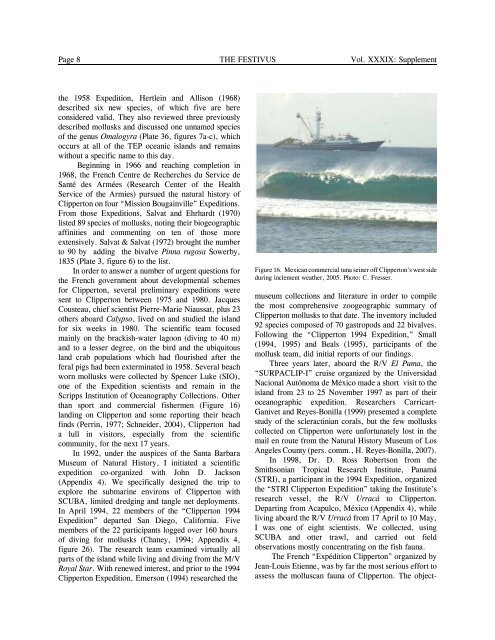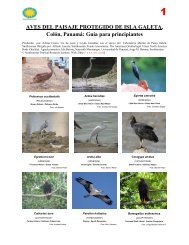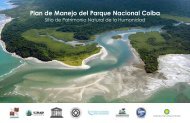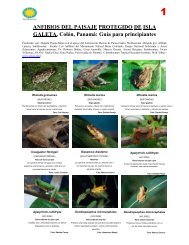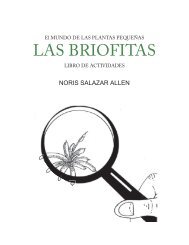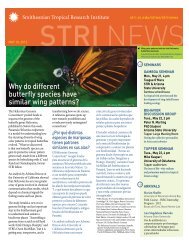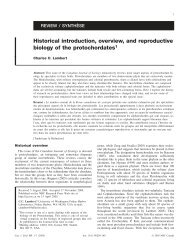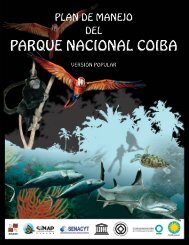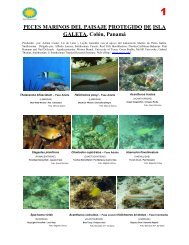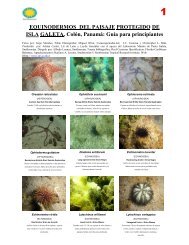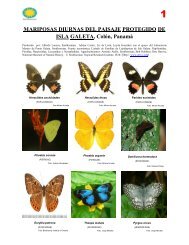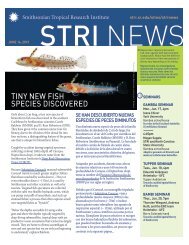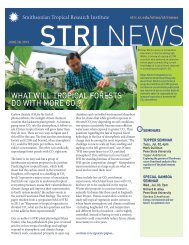Download - Smithsonian Tropical Research Institute - Smithsonian ...
Download - Smithsonian Tropical Research Institute - Smithsonian ...
Download - Smithsonian Tropical Research Institute - Smithsonian ...
Create successful ePaper yourself
Turn your PDF publications into a flip-book with our unique Google optimized e-Paper software.
Page 8 THE FESTIVUS Vol. XXXIX: Supplement<br />
the 1958 Expedition, Hertlein and Allison (1968)<br />
described six new species, of which five are here<br />
considered valid. They also reviewed three previously<br />
described mollusks and discussed one unnamed species<br />
of the genus Omalogyra (Plate 36, figures 7a-c), which<br />
occurs at all of the TEP oceanic islands and remains<br />
without a specific name to this day.<br />
Beginning in 1966 and reaching completion in<br />
1968, the French Centre de Recherches du Service de<br />
Santé des Armées (<strong>Research</strong> Center of the Health<br />
Service of the Armies) pursued the natural history of<br />
Clipperton on four “Mission Bougainville” Expeditions.<br />
From those Expeditions, Salvat and Ehrhardt (1970)<br />
listed 89 species of mollusks, noting their biogeographic<br />
affinities and commenting on ten of those more<br />
extensively. Salvat & Salvat (1972) brought the number<br />
to 90 by adding the bivalve Pinna rugosa Sowerby,<br />
1835 (Plate 3, figure 6) to the list.<br />
In order to answer a number of urgent questions for<br />
the French government about developmental schemes<br />
for Clipperton, several preliminary expeditions were<br />
sent to Clipperton between 1975 and 1980. Jacques<br />
Cousteau, chief scientist Pierre-Marie Niaussat, plus 23<br />
others aboard Calypso, lived on and studied the island<br />
for six weeks in 1980. The scientific team focused<br />
mainly on the brackish-water lagoon (diving to 40 m)<br />
and to a lesser degree, on the bird and the ubiquitous<br />
land crab populations which had flourished after the<br />
feral pigs had been exterminated in 1958. Several beach<br />
worn mollusks were collected by Spencer Luke (SIO),<br />
one of the Expedition scientists and remain in the<br />
Scripps Institution of Oceanography Collections. Other<br />
than sport and commercial fishermen (Figure 16)<br />
landing on Clipperton and some reporting their beach<br />
finds (Perrin, 1977; Schneider, 2004), Clipperton had<br />
a lull in visitors, especially from the scientific<br />
community, for the next 17 years.<br />
In 1992, under the auspices of the Santa Barbara<br />
Museum of Natural History, I initiated a scientific<br />
expedition co-organized with John D. Jackson<br />
(Appendix 4). We specifically designed the trip to<br />
explore the submarine environs of Clipperton with<br />
SCUBA, limited dredging and tangle net deployments.<br />
In April 1994, 22 members of the “Clipperton 1994<br />
Expedition” departed San Diego, California. Five<br />
members of the 22 participants logged over 160 hours<br />
of diving for mollusks (Chaney, 1994; Appendix 4,<br />
figure 26). The research team examined virtually all<br />
parts of the island while living and diving from the M/V<br />
Royal Star. With renewed interest, and prior to the 1994<br />
Clipperton Expedition, Emerson (1994) researched the<br />
Figure 16. Mexican commercial tuna seiner off Clipperton’s west side<br />
during inclement weather, 2005. Photo: C. Fresser.<br />
museum collections and literature in order to compile<br />
the most comprehensive zoogeographic summary of<br />
Clipperton mollusks to that date. The inventory included<br />
92 species composed of 70 gastropods and 22 bivalves.<br />
Following the “Clipperton 1994 Expedition,” Small<br />
(1994, 1995) and Beals (1995), participants of the<br />
mollusk team, did initial reports of our findings.<br />
Three years later, aboard the R/V El Puma, the<br />
“SURPACLIP-I” cruise organized by the Universidad<br />
Nacional Autónoma de México made a short visit to the<br />
island from 23 to 25 November 1997 as part of their<br />
oceanographic expedition. <strong>Research</strong>ers Carricart-<br />
Ganivet and Reyes-Bonilla (1999) presented a complete<br />
study of the scleractinian corals, but the few mollusks<br />
collected on Clipperton were unfortunately lost in the<br />
mail en route from the Natural History Museum of Los<br />
Angeles County (pers. comm., H. Reyes-Bonilla, 2007).<br />
In 1998, Dr. D. Ross Robertson from the<br />
<strong>Smithsonian</strong> <strong>Tropical</strong> <strong>Research</strong> <strong>Institute</strong>, Panamá<br />
(STRI), a participant in the 1994 Expedition, organized<br />
the “STRI Clipperton Expedition” taking the <strong>Institute</strong>’s<br />
research vessel, the R/V Urracá to Clipperton.<br />
Departing from Acapulco, México (Appendix 4), while<br />
living aboard the R/V Urracá from 17 April to 10 May,<br />
I was one of eight scientists. We collected, using<br />
SCUBA and otter trawl, and carried out field<br />
observations mostly concentrating on the fish fauna.<br />
The French “Expédition Clipperton” organized by<br />
Jean-Louis Etienne, was by far the most serious effort to<br />
assess the molluscan fauna of Clipperton. The object-


